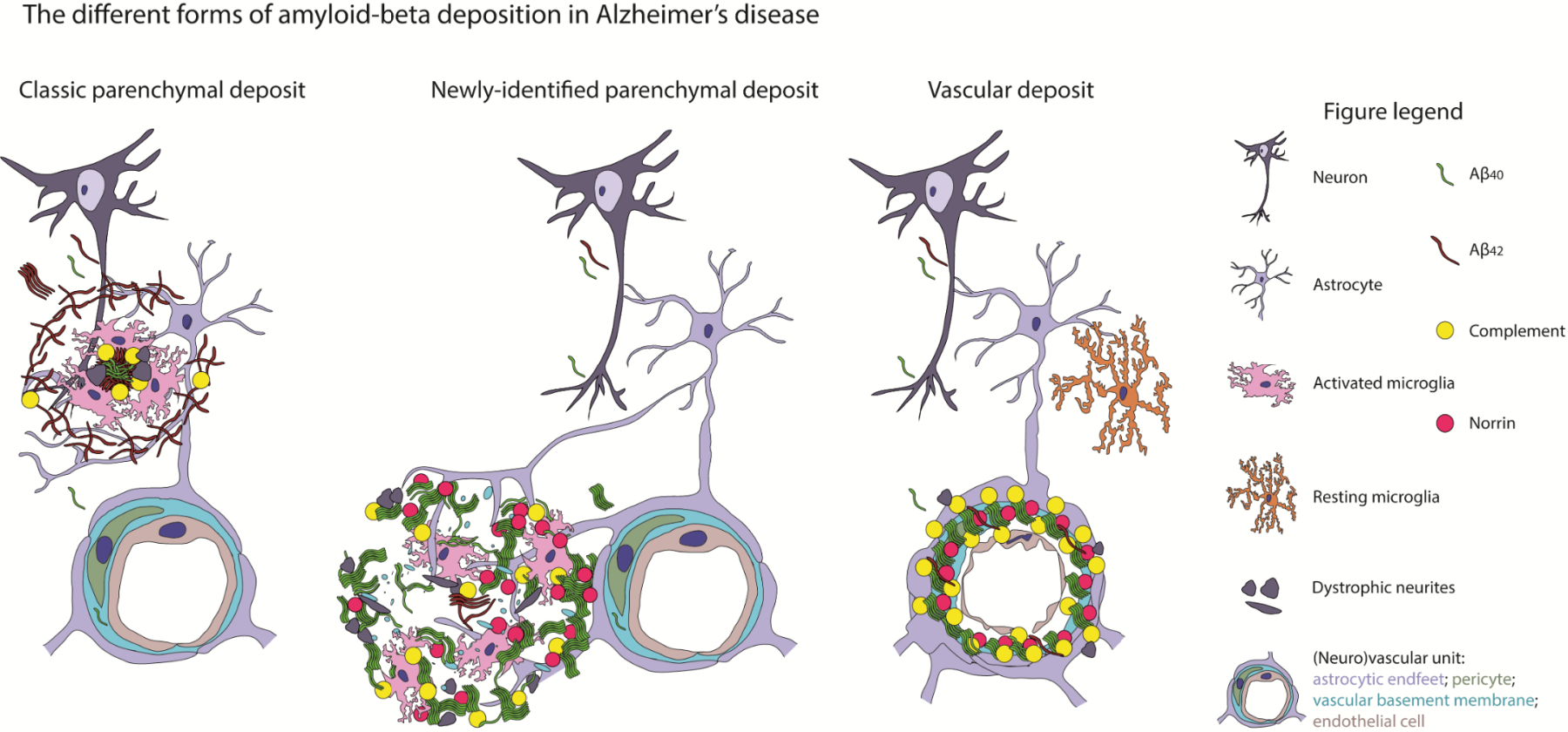Scientists have discovered a type of amyloid-β plaque in the brains of people with early-onset Alzheimer’s disease that has not been observed before. These “coarse-grained” plaques, described in a study published last week in Acta Neuropathologica, have a different structure, composition, and distribution from the typical amyloid plaques that have been well-studied in the disease.
“For a different study, we were looking into the neuroinflammatory response in early-onset AD cases,” says Baayla Boon, a PhD candidate in pathology at Amsterdam UMC and the lead author of the study. Examining post-mortem brain slices from this small group of similar cases, she noticed a lot of plaques that appeared darker than expected under the microscope. “We realized that these plaques look different from what we actually knew,” she says.
The researchers then followed up by comparing the brains of 74 people who had recently died—15 without Alzheimer’s disease, 38 with early-onset, and 21 with late-onset. Most of the early-onset samples contained large amounts of these coarse-grained plaques, while most late-onset cases had little or none. “We couldn’t really find studies reporting these plaques,” says Boon. “We’ve been looking at this disease for so many years—how can it be that we now suddenly find a new plaque? We were mostly flabbergasted by that.”
Plaques made up of amyloid-β peptides are one of the hallmarks of Alzheimer’s disease, although their role in neurodegeneration is unclear. Boon and her colleagues probed the molecular make-up of the new plaques to understand how they might form. A key difference they uncovered is that the coarse-grained plaques have more of a shorter version of amyloid-β, compared to the plaques usually seen in brain tissue. The coarse-grained plaques bear resemblance to the amyloid-β build-up in the brain’s blood vessels seen in a disease known as cerebral amyloid angiopathy, which causes brain bleeds in older people.
In addition, most of the coarse-grained plaques were in direct contact with blood vessels and the researchers found markers of vascular damage.
“It’s absolutely interesting. It adds to the understanding and increasing evidence for the links between the brain’s vascular system and the development of Alzheimer’s pathology,” says Tormod Fladby, who researches the development of Alzheimer’s disease at the University of Oslo and was not involved in the study. “It also adds to the differentiation between distinct types of Alzheimer’s pathologies, which may turn out to be very relevant when it comes to developing intervention strategies.”

The authors’ proposed model for three types of amyloid-β deposits in the brain: the classic plaque well-known in Alzheimer’s disease, the newly discovered coarse-grained plaque, and plaques seen in cerebral amyloid angiopathy (CAA), a disease of the brain’s blood vessels. The coarse-grained plaque shares features of the CAA plaque in that it has more of the short version of amyloid-β (Aβ40) than the long one (Aβ42) and is situated near blood vessels in the brain. The model also represents damage in the brain, including dystrophic neurites (damaged parts of neurons), norrin (a marker of vascular damage), and complement (a marker for neuroinflammation).
Boon also says she thinks that doctors may need a different strategy to find treatments for cases with these coarse-grained deposits, including helping to remove them from the brain. If the different plaques need different treatment approaches, this mixture of disease subtypes may be a reason why so many potential treatments appear to have failed in clinical trials.
“It could definitely be an explanation because we now put all the AD cases into one pile. I think we need to find something so that we can predict what kind of amyloid-β deposits are in the brain so that we can stratify these patients better,” says Boon.
The team used different antibodies to identify the presence of the longer and shorter versions of amyloid-β in the plaques, as well as markers of damage to the brain. This approach is useful for producing a qualitative image for the distribution of the peptides, but other techniques are required to produce reliable figures on the amount of protein present, such as mass spectrometry.
“That, I think, is the gold standard to quantify proteins these days. I’m quite surprised that they did not do that and that they relied solely on antibodies,” says Jörg Hanrieder, a neurochemist at the University of Gothenburg in Sweden who was not involved with the study. “Because from our experience, these antibodies are not specific enough, particularly not in tissue.”
There is only a two-amino-acid difference between the longer and shorter versions of amyloid-β, making it challenging to distinguish them using antibodies. Better quantification of the composition of the plaques will give a clearer idea of the mechanisms at work.
Boon and her colleagues are now planning to use mass spectrometry to do this, as well as trying to recreate these plaques in mice to test the idea that the development of these plaques are closely linked to the blood vessels. “We can’t prove our hypothesis on how it develops in this kind of study; you need models for that.”
B.D.C. Boon et al. “The coarse-grained plaque: a divergent Aβ plaque-type in early-onset Alzheimer’s disease,” Acta Neuropathol, doi:10.1007/s00401-020-02198-8, 2020.
"type" - Google News
September 28, 2020 at 10:32PM
https://ift.tt/2G0m5h8
Newly Found Alzheimer’s Plaque Type Linked to Early-Onset Disease - The Scientist
"type" - Google News
https://ift.tt/2WhN8Zg
https://ift.tt/2YrjQdq
Bagikan Berita Ini














0 Response to "Newly Found Alzheimer’s Plaque Type Linked to Early-Onset Disease - The Scientist"
Post a Comment